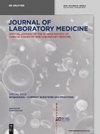Impact and frequency of IV fluid contamination on basic metabolic panel results using quality metrics
IF 1.8
4区 医学
Q4 MEDICAL LABORATORY TECHNOLOGY
引用次数: 0
Abstract
Objectives Clinical laboratories invest substantial time and resources to mitigate measurement error but potential errors during the preanalytical phase of testing are not subjected to the same level of scrutiny. Herein, we assess the proportions of intravenous (IV) fluid contamination sufficient to exceed common performance metrics and compare it to contaminated results flagged by current protocols. Methods Basic metabolic panels performed between 01/2017 and 07/2022 were extracted from the laboratory information system (n=928,742). Contamination was simulated for common IV fluid types. The thresholds at which contaminated results exceeded total allowable error (TEa), reference change values (RCV), or changed normality/critical flags were calculated. The mixture ratio of IV fluid contamination detected by technologists during routine analysis was estimated. Results The TEa and RCV was exceeded at a mixture ratio ≤0.10 for chloride, glucose, calcium, and potassium for both normal saline (NS) and 5 % dextrose in water (D5W). At a simulated mixture ratio of 0.10, 51.39 % of calcium and 21.17 % of potassium results would be expected to be incorrectly reported with an abnormal/critical flag with NS contamination and 99.74 % of sodium and 100 % of glucose results to be incorrectly flagged with D5W. Retrospective results flagged as contaminated revealed a median mixture ratio of 0.18 and 0.24 for D5 and non-D5 fluids. Conclusions At a mixture ratio of at least 0.10, IV fluid contamination causes relevant error between patients’ true concentrations and those reported. However, current procedures cannot reliably detect 10 % contamination.使用质量指标衡量静脉注射液污染对基础代谢检查结果的影响和频率
目的 临床实验室投入了大量的时间和资源来减少测量误差,但分析前检测阶段的潜在误差却没有受到同等程度的审查。在此,我们评估了足以超出普通性能指标的静脉注射液(IV)污染比例,并将其与现行方案标记的污染结果进行比较。方法 从实验室信息系统(n=928,742)中提取 2017 年 1 月至 2022 年 7 月期间进行的基础代谢检查。模拟了常见静脉注射液类型的污染情况。计算了污染结果超过总允许误差 (TEa)、参考变化值 (RCV) 或正常值/临界标志变化的阈值。估算了技术人员在常规分析过程中检测到的静脉注射液污染的混合比率。结果 当正常生理盐水(NS)和 5%葡萄糖水(D5W)的氯化物、葡萄糖、钙和钾的混合比≤0.10 时,TEa 和 RCV 均超标。在模拟混合比为 0.10 的情况下,预计 51.39% 的钙和 21.17% 的钾结果会因正常生理盐水污染而被错误报告为异常/危急标记,而 99.74% 的钠和 100% 的葡萄糖结果会因 D5W 而被错误标记。被标记为受污染的回顾性结果显示,D5 和非 D5 流体的中位混合比分别为 0.18 和 0.24。结论 当混合比至少为 0.10 时,静脉注射液污染会导致患者的真实浓度与报告浓度之间出现误差。然而,目前的程序无法可靠地检测出 10% 的污染。
本文章由计算机程序翻译,如有差异,请以英文原文为准。
求助全文
约1分钟内获得全文
求助全文
来源期刊

Journal of Laboratory Medicine
Mathematics-Discrete Mathematics and Combinatorics
CiteScore
2.50
自引率
0.00%
发文量
39
审稿时长
10 weeks
期刊介绍:
The Journal of Laboratory Medicine (JLM) is a bi-monthly published journal that reports on the latest developments in laboratory medicine. Particular focus is placed on the diagnostic aspects of the clinical laboratory, although technical, regulatory, and educational topics are equally covered. The Journal specializes in the publication of high-standard, competent and timely review articles on clinical, methodological and pathogenic aspects of modern laboratory diagnostics. These reviews are critically reviewed by expert reviewers and JLM’s Associate Editors who are specialists in the various subdisciplines of laboratory medicine. In addition, JLM publishes original research articles, case reports, point/counterpoint articles and letters to the editor, all of which are peer reviewed by at least two experts in the field.
 求助内容:
求助内容: 应助结果提醒方式:
应助结果提醒方式:


